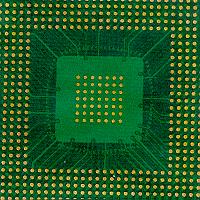Palomar Technologies Assembly Services (“Assembly Services”) offers unique assembly methods supporting flux-less Micro Ball Grid Array (BGA) solder reflow. More specifically, Assembly Services has recently developed a solder reflow process for SAC405 Micro BGAs without the need for a flux. This is accomplished through the Palomar Technologies patented Pulse Heat Stage (PHS) and forming gas—either ultra-pure Nitrogen or Hydrogen/Nitrogen mix. The Palomar Technologies suite of pick-and-place equipment utilized in the precision microelectronic assembly solutions division has supported complex eutectic solder reflow for more than 20 years, so as BGA designs become smaller and more complex our years of experience appear to be a perfect match.
The use of nickel-doped SAC solders has become more popular with varieties of SAC105, SAC305 and SAC405. These tin-silver-copper lead-free solder alloys allow for clean reflow onto Ni/Au plated metallization; however this typically requires a flux and a long-belt furnace reflow profile. Assembly Services’ solution automatically places the carrier onto the PHS, pick and places the Micro BGA component, seals an inert environment via an automated shutter and reflows the solder under 45 seconds—larger carries may require longer profiles so the precise timing depends on package geometries.
 Today, Assembly Services has successfully demonstrated reliable flux-less reflow for Micro BGAs down to 120µm pitch and will soon reduce to 85µm. Destructive shear testing combined with ultrasonic inspection demonstrates this process to be a very reliable interconnect that is relatively void free. In fact, to date we have yet to determine the ultimate device shear value since the failure mode is has been the carrier metallization.
Today, Assembly Services has successfully demonstrated reliable flux-less reflow for Micro BGAs down to 120µm pitch and will soon reduce to 85µm. Destructive shear testing combined with ultrasonic inspection demonstrates this process to be a very reliable interconnect that is relatively void free. In fact, to date we have yet to determine the ultimate device shear value since the failure mode is has been the carrier metallization.
The obvious advantage of this assembly technique is a relatively fast and clean process. Assembly Services uses mixed technologies—such as chip and wire—since we’re using microelectronic assembly equipment in a clean room environment. This allows for the process of all Micro BGA components the ability to then move to traditional die attach and wire bond processes for active components not available in a package format.
A prior reliability study (Interfacial Reactions of Ni-doped SAC105 and SAC405 Solders on Ni-Au Finish during Multiple Reflows, ICEPT2007 Proceedings) has demonstrated how these solders can be exposed to multiple reflow cycles. This says that one could process the Micro BGA component(s) first and then move onto more traditional SMT assembly methods that do not support Micro BGA designs.
----
Donald Beck
Assembly Services General Manager
Palomar Technologies